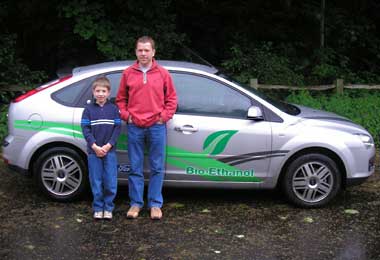Ford Focus Ffv/Morrisons E85
Ford's new Focus FFV can run very efficiently on green bioethanol fuel. The trouble is, it's hard to find it on the forecourt, says David Wilkins

Model: Ford Focus Ghia FFV/Morrisons E85
Price: From £15,860 (Focus five-door LX)
Engine: 1.8-litre petrol
Performance: 0-62 mph in 10.3 seconds, 40.4 mpg (on unleaded)
CO2: 169g/km (on unleaded)
Worth considering: Honda Civic Hybrid, Saab 9-5 BioPower, Toyota Prius
Ford's new Focus FFV (Flexi-Fuel Vehicle) can run on E85, a mixture of 85 per cent bioethanol and 15 per cent petrol sold at selected Morrisons filling stations.
Why is that a good thing? Well, bioethanol is a plant-based fuel, so it's renewable, and the crops used in its production absorb CO2 before they are harvested, offsetting an estimated 70 per cent of the car's later carbon emissions. The FFV can also use standard unleaded.
Saab's 9-5 BioPower, the other E85-capable model available in the UK, uses bioethanol's higher octane rating to boost horse power by 20 per cent but Ford has taken a different tack and designed the FFV, for which it charges a premium of £200 or less, to feel as much like an unmodified Focus as possible.
In that, it has succeeded; the FFV is undistinguishable in everyday use from the standard model. And refuelling with E85 is as easy as filling up with unleaded. With the help of our readers, I visited all five Morrisons E85 filling stations in East Anglia during our test, and we refilled at four.
Morrisons' staff took the arrival of the FFV in their stride, even though in some cases we were apparently the first customers ever to buy E85.
So what's the catch? Well, when we carried out our test in late May, Morrisons was selling E85 for just 2p per litre less than unleaded. Ford concedes that the FFV's fuel consumption takes a 25 per cent hit when running on E85 because bioethanol has a lower energy content than petrol.
That means that if you want to save money, this is not the way to go - unless Morrisons can be persuaded to drop the price. But if you want to reduce your carbon footprint and you don't mind paying a bit more for your motoring, the FFV could be the answer.
One snag is that, although the manufacturers provide broad estimates, there are no official fuel consumption or CO2 emissions data for cars running E85; the figures in our table are for the FFV running on unleaded.
This makes it difficult for customers to calculate the size of the CO2 reduction they are buying for each extra pound they spend on E85. We are presently devising a test that should help us quantify more precisely the fuel consumption penalty associated with E85, which we hope will help you to make up your mind.
In the meantime, let's give Ford and Morrisons, along with Saab, a pat on the back for at least getting E85 on sale and demonstrating that the cars and refuelling arrangements work.
Jill O'Loughlin, 38, Guest services manager, Lowestoft
USUAL CAR: PORSCHE BOXSTER
The Morrisons cashier was so surprised that someone had used bioethanol she thought it was a mistake. I drove the Focus around town, on country lanes and on the A12 and found no apparent lack of power, but unless fuel suppliers follow Ford's "going green" example, owners of bioethanol cars may use more unleaded due to the fuel's very limited availability. The only difference I could find is that the bioethanol-powered Focus will cost you just under £200 more than an unleaded Focus to buy, and you will save a measly 2p per litre on fuel, although you will be reducing CO2 emissions - and, as there is no separate fuel tank, you get to keep the boot space!
Nigel and Ben Schofield, 41 and 7, Site engineer, Bury St Edmunds
USUAL CAR: FORD FOCUS
Having just covered more than 100,000 miles in the Mk 1 petrol Focus, it was intriguing to see the difference between the old and new. I was expecting it to be maybe slower, either noisier or quieter, and smellier. All appeared normal, even filling up at one of the rare fuel stations. The Focus didn't suffer for running on a green fuel - along the dual carriageway it was responsive and around the lanes of Suffolk it was a good, precise drive. I thought the handbrake was offset too much, but Ben liked the extra space in the back. I like the idea of a green fuel but it needs to be more widely available, particularly for high milers.
Adam Owen, 33, Chartered accountant, Great Yarmouth
USUAL CARS/BIKE: HONDA FR-V, MERCEDES C230K, SUZUKI DRZ400S
Like all mainstream manufacturers, Ford suffers from striving to make cars that no one will dislike. The downside is that invariably you end up with cars that very few people really desire. The afternoon I spent with the Focus was pretty uneventful. The car does its job well but I could not warm to the uniform Ford dashboard layout, the dull plastics and the mediocre engine. As for bioethanol fuel, I can understand and applaud the environmental benefit but from a cost and convenience perspective it doesn't add up. The fuel is currently only 2p a litre cheaper than unleaded and returns less miles per gallon.
THE VERDICT
If you would like to take part, e-mail motoring@independent.co.uk or write to: The Verdict, Features Department, Independent House, 191 Marsh Wall, London E14 9RS, giving your address, phone number and details of the car, if any, you drive. For most cars, participants must be over 26 and have a clean licence.
Join our commenting forum
Join thought-provoking conversations, follow other Independent readers and see their replies
Comments
Bookmark popover
Removed from bookmarks